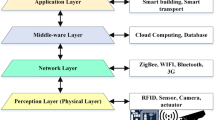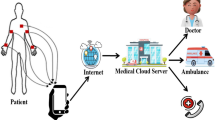Abstract
In wireless sensor network (WSN), the secure communication and exchange of confidential information between nodes is a challenging task. To eliminate the security flaws WSN adopts authenticated cryptography mechanisms. The authenticated key agreement protocol guarantees the reality of the users and negotiates the shared session key. In the past years, the two-way authentication scheme has been proved as a better approach for secure and energy efficient communication over Bin and Balls Authentication scheme, Timed Efficient Stream Loss-Tolerant Authentication scheme and so on. However, the recently established identity based protocols are associated with the flaws like inadequate security, high computation cost and latency in communication to a larger extent. The issues related to cost is raised because of the pairing and mapping functionalities in the state-of-the-art techniques. This paper proposes a pairing-free identity based two-party authenticated key agreement protocol based on hexadecimal extended ASCII Elliptic Curve Cryptography. The proposed scheme is developed in an adequate manner with the increased security strength and reduced cost. The security of this protocol is tightened by the extended ASCII code representation of the identity of the user. The performance of this protocol is compared with the Bin and Balls Authentication scheme, Loss-Tolerant Authentication scheme and recently proposed Ramachandran and Shanmugam scheme that show our scheme outperforms these three authentication schemes.






Similar content being viewed by others
References
Sohrabi, K., Gao, J., Ailawadhi, V., & Pottie, G. J. (2000). Protocols for self-organization of a wireless sensor network. IEEE Personal Communications, 7(5), 16–27.
Arampatzis, Th., Lygeros, J., & Manesis, S. (2005). A survey of applications of wireless sensors and wireless sensor networks. The Proceedings of Intelligent Control, 1, 719–724.
Ferrag, M. A., Maglaras, L. A., Janicke, H., Jiang, J., & Shu, L. (2018). A Systematic Review of Data Protection and Privacy Preservation Schemes for Smart Grid Communications. Sustainable Cities and Society., 38, 806–835.
Pantazis, N. A., Nikolidakis, S. A., & Vergados, D. D. (2013). Energy-efficient routing protocols in wireless sensor networks: A survey. IEEE Communications Surveys and Tutorials, 15(2), 551–591.
Othman, J. B., & Yahya, B. (2010). Energy efficient and QoS based routing protocol for wireless sensor networks. Journal of Parallel and Distributed Computing, 70(8), 849–857.
Xiang, L., Luo, J., & Vasilakos, A. (2011). Compressed data aggregation for energy efficient wireless sensor networks. The Proceedings of Sensor, Mesh and Ad Hoc Communications and Networks, 1, 46–54.
Gomez, C., & Paradells, J. (2010). Wireless home automation networks: A survey of architectures and technologies. IEEE Communications Magazine, 48(6), 92–101.
Das, M. L. (2009). Two-factor user authentication in wireless sensor networks. IEEE Transactions on Wireless Communications, 8(3), 1086–1090.
Xie, M., Han, S., Tian, B., & Parvin, S. (2011). Anomaly detection in wireless sensor networks: A survey. Journal of Network and Computer Applications, 34(4), 1302–1325.
Diffie, W., Oorschot, P. C. V., & Wiener, M. J. (1992). Authentication and authenticated key exchanges. Designs, Codes and Cryptography, 2(2), 107–125.
Paterson, K. G., & Price, G. (2003). A comparison between traditional public key infrastructures and identity-based cryptography. Information Security Technical Report, 8(3), 57–72.
Hwu, J. S., Chen, R. J., & Lin, Y. B. (2006). An efficient identity-based cryptosystem for end-to-end mobile security. IEEE Transactions on Wireless Communications, 5(9), 2586–2593.
Vladimir S. (2016). Post-quantum elliptic curve cryptography. UWSpace. http://hdl.handle.net/10012/10488.
Merwe, J. V. D., Dawoud, D., & McDonald, S. (2007). A survey on peer-to-peer key management for mobile ad hoc networks. ACM Computing Surveys (CSUR), 39(1), 1.
Anciaux, N., Bouganim, L., & Pucheral, P. (2006). Data confidentiality: To which extent cryptography and secured hardware can help. Annals of Telecommunications, 61(3), 267–283.
Kumar, A., & Tripathi, S. (2015). A pairing free anonymous certificateless group key agreement protocol for dynamic group. Wireless Personal Communications, 82(2), 1027–1045.
Islam, S. K. H., & Bisis, G. P. (2012). A pairing-free identity-based authenticated group key agreement protocol for imbalanced mobile networks. Annals of Telecommunications, 67(11), 547–558.
Islam, S. K. H., & Khan, M. K. (2016). Provably secure and pairing-free identity-based handover authentication protocol for wireless mobile networks. International Journal of Communication Systems, 29(17), 2442–2456.
Ramachandran, S., & Shanmugam, V. (2017). A two way authentication using bilinear mapping function for wireless sensor networks. Computers and Electrical Engineering, 5(4), 1–8.
Hou, J., Qu, L., & Shi, W. (2019). A survey on internet of things security from data perspectives. Computer Networks, 148, 295–306.
Tan, Z. (2013). A communication and computation-efficient three-party authenticated key agreement protocol. Security and Communication Networks, 6(7), 854–863.
Jan, M., Nanda, P., Usman, M., & He, X. (2016). PAWN: A payload-based mutual authentication scheme for wireless sensor networks. Concurrency and Computation: Practice and Experience, 1, 1–10.
Amin, R., & Bisis, G. P. (2016). A secure light weight scheme for user authentication and key agreement in multi-gateway based wireless sensor networks. Ad Hoc Networks, 36(1), 58–80.
Das, A. K. (2016). A secure and robust temporal credential-based three-factor user authentication scheme for wireless sensor networks. Peer-to-peer Networking and Applications, 9(1), 223–244.
Liu, Y., Dong, M., Ota, K., & Liu, A. (2016). ActiveTrust: Secure and trustable routing in wireless sensor networks. IEEE Transactions on Information Forensics and Security, 11(9), 2013–2027.
Bala, S., Sharma, G., & Verma, A. K. (2016). PF-ID-2PAKA: Pairing free identity-based two-party authenticated key agreement protocol for wireless sensor networks. Wireless Personal Communications, 87(3), 995–1012.
Ray, S., & Bisis, G. P. (2013). Design of Mobile Public Key Infrastructure (M-PKI) using Elliptic Curve Cryptography. International Journal on Cryptography and Information Security (IJCIS), 3(1), 25–37.
Ni, L., Chen, G., Li, J., & Hao, Y. (2016). Strongly secure identity-based authenticated key agreement protocols without bilinear pairings. Information Sciences, 67(368), 176–193.
Ray, S., & Bisis, G. P. (2014). Design of an efficient mobile health system for achieving HIPAA privacy-security regulations. International Journal of Wireless and Mobile Computing, 7(4), 378.
Ray, S., Bisis, G. P., & Dasgupta, M. (2016). Secure multi-purpose mobile-banking using elliptic curve cryptography. Wireless Personal Communications, 90(3), 1331–1354.
Cao, X., Kou, W., & Du, X. (2010). A pairing-free identity-based authenticated key agreement protocol with minimal message exchanges. Information Sciences, 180(15), 2895–2903.
Lu, Y., Zhang, Q., Li, J., & Shen, J. (2016). Comment on a Certificateless One-Pass and Two-Party Authenticated Key Agreement Protocol. Information Sciences, 369(1), 184–187.
Tsai, J. L., & Lo, Nai-Wei. (2016). Secure anonymous key distribution scheme for smart grid. IEEE Transactions on Smart Grid, 7(2), 906–914.
Mohammadali A., Haghighi M. S., Tadayon A., Mohammadinodooshan A. (2016) A Novel Identity-Based Key Establishment Method for Advanced Metering Infrastructure in Smart Grid, IEEE Transactions on Smart Grid, 1, 1–1.
Odelu, V., Das, A. K., & AdrijitGoswami, . (2016). SEAP: Secure and Efficient Authentication Protocol for NFC Applications using Pseudonyms. IEEE Transactions on Consumer Electronics, 62(1), 30–38.
Hayashi, M., Tyagi, H., & Watanabe, S. (2016). Secret Key Agreement: General Capacity and Second-Order Asymptotics. IEEE Transactions on Information Theory, 62(7), 3796–3810.
Qiu, Y., & Ma, Maode. (2016). A Mutual Authentication and Key Establishment Scheme for M2M Communication in 6LoWPAN Networks”. IEEE Transactions on Industrial Informatics, 12(6), 2074–2085.
Liu, J. K., Baek, J., Zhou, J., Yang, Y., & Wong, J. W. (2010). Efficient Online/offline Identity-based Signature for Wireless Sensor Network. Internation Journal of Information Security, 9(4), 287–296.
Lou, D. C., & Huang, H.-F. (2011). Efficient Three-Party Password-based Key Exchange Scheme”. International Journal of Communication Systems, 24(4), 504–512.
He, D., Chen, J., & Zhang, Rui. (2011). An efficient identity-based blind signature scheme without bilinear pairings. Computers and Electrical Engineering, 37(4), 444–450.
Bing, C. H., Geng, Y., Tao, W. J., & Xiao, H. (2006). An authenticated identity-based key establishment and encryption scheme for wireless sensor networks. The Journal of China Universities of Posts and Telecommunications, 13(2), 31–38.
Oliveira, L. B., Dahab, R., Lopez, J., Daguano, F., & Loureiro, A. A. F. (2007). Identity-based encryption for sensor networks. The Proceedings of Pervasive Computing and Communications, 1, 290–294.
Islam, S. K. H., & Bisis, G. P. (2015). A pairing-free identity-based two-party authenticated key agreement protocol for secure and efficient communication. Journal of King Saud University-Computer and Information Sciences, 29(1), 63–73.
Oliveira, L. B., Aranha, D. F., Gouvea, C. P. L., Scott, M., Camara, D. F., Lopez, J., & Dahab, R. (2011). TinyPBC: Pairings for authenticated identity-based non-interactive key distribution in sensor networks. Computer Communications, 34(3), 485–493.
Geng, Y., Chumming, R., Christian, V., Tao, W. J., & Bing, C. H. (2006). Identity-based key agreement and encryption for wireless sensor networks. The Journal of China Universities of Posts and Telecommunications, 13(4), 54–60.
Yang, J.-H., & Chang, C.-C. (2009). An ID-based remote mutual authentication with key agreement scheme for mobile devices on elliptic curve cryptosystem. Computers and Security, 28(3), 138–143.
Sadhukhan, D., Ray, S., Biswas, G. P., Khan, M. K., & Dasgupta, Mou. (2020). A lightweight remote user authentication scheme for IoT communication using elliptic curve cryptography. Journal of Supercomputing., 77, 1114–1151.
Majumder, S., Ray, S., Sadhukhan, D., et al. (2021). ECC-CoAP: Elliptic curve cryptography based constraint application protocol for internet of things. Wireless Pers Commun, 116, 1867–1896. https://doi.org/10.1007/s11277-020-07769-2.
Simplicio, M. A., Jr., Silva, M. V. M., Alves, R. C. A., & Tiago, K. C. S. (2017). Lightweight and escrow-less authenticated key agreement for the internet of things. Computer Communications, 98(1), 43–51.
Shyamala, R., & Shanmugam, V. (2013). An approach to secure leach using tesla based certificate. Life Science Journal, 10(2), 1018–1027.
Acknowledgements
Authors are immensely grateful to the Editor-in-Chief, Editors and anonymous reviewers for their precious comments and beneficial suggestions to improve the paper. The research work is supported by Ministry of Education, Government of India. Muhammad Khurram Khan is supported by researchers supporting project number (RSP-2020/12), King Saud University, Riyadh, Saudi Arabia.
Author information
Authors and Affiliations
Corresponding author
Additional information
Publisher's Note
Springer Nature remains neutral with regard to jurisdictional claims in published maps and institutional affiliations.
Rights and permissions
About this article
Cite this article
Kumar, V., Ray, S., Dasgupta, M. et al. A Pairing Free Identity Based Two Party Authenticated Key Agreement Protocol Using Hexadecimal Extended ASCII Elliptic Curve Cryptography. Wireless Pers Commun 118, 3045–3061 (2021). https://doi.org/10.1007/s11277-021-08168-x
Accepted:
Published:
Issue Date:
DOI: https://doi.org/10.1007/s11277-021-08168-x




